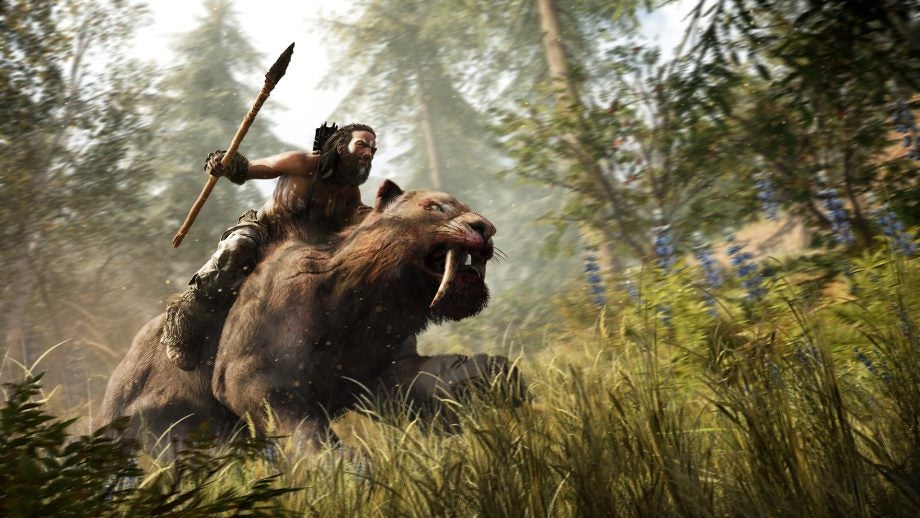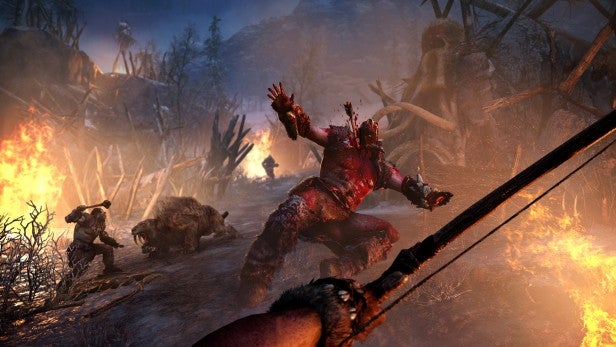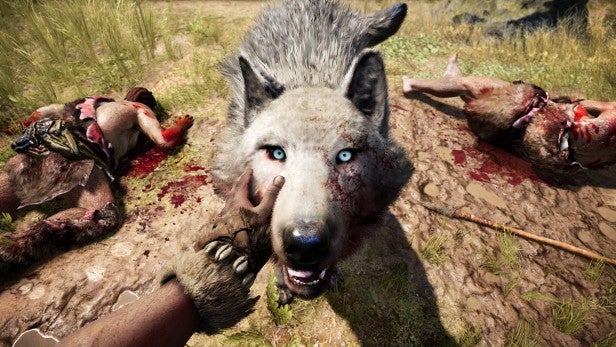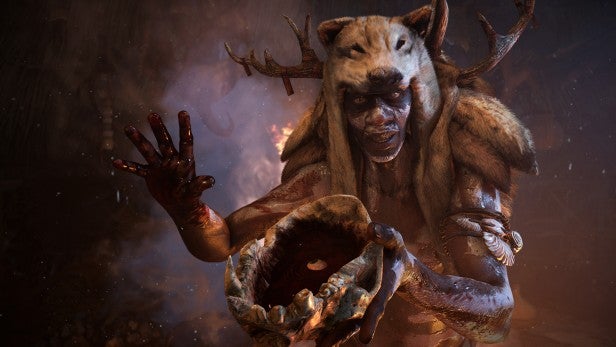Far Cry Primal Review
Far Cry Primal
A brilliant re-imagining of the Far Cry universe

Verdict
Pros
- Fantastic wilderness setting
- Compelling mesh of systems, story and action
- Brilliant beastmaster mechanics
- Utterly immersive and addictive
Cons
- Unbelievably vicious wildlife (really, badgers?)
- Reliant on established Far Cry structure
- No co-op
Key Specifications
- Review Price: £39.50
One of the great things games can do is give us a glimpse of a different world. It might not be authentic, lifelike, realistic or remotely believable. It might be a fantasy, dream or nightmare. What matters is that it feels – if only for a few hours – convincing, and that it takes you out of your mundane life.
The problem is that so many games fixate on giving you the same experience. What’s it like to be a soldier, fighting out beyond the front lines, or a space marine, a criminal, a touring car driver or a warrior? We keep finding out. What’s so brilliant about Far Cry: Primal is that it takes us somewhere and gives us something different. It’s not just Far Cry with cavemen, but a re-imagining of the open world shooter for a world 12,000 years ago.
Watch 5 things you need to know about Far Cry Primal
Let’s not go crazy. Primal isn’t out to reinvent the Far Cry wheel. You don’t have to look far beneath the Stone Age surface to see the well-established Ubisoft open world structure. This is still a game of exploring, taking and expanding territory, attacking enemy outposts and lighting bonfires to enlarge your area of influence, while developing relationships to give you access to new skills and equipment.
You’ll still be taking part in a string of story missions while tackling side activities and repeated, semi-random events,

Yet, in a way, the change of setting transforms everything. More than just a shooter with Flint-tipped arrows instead of bullets, this is a bold, striking and often brutal tale of primitive warfare and survival. It’s still recognizably Far Cry, but not Far Cry as you know and love it.
Here you play Takkar of the Wenja – a fictional tribe of Central Europe, circa 10,000 BC. The Wenja have been scattered, small groups wandering the plains and mountains, until Takkar, split from his own group, discovers Oros, a hidden land of plenty.
There are other Wenja here – tribesmen and women to be bought together – but also rival tribes looking to conquer: the fire-wielding Izila and the brutish, man-eating Udam. What’s more, while Oros has fruit and leaves to gather and goats, deer and more to hunt, it’s also home to a range of ferocious predators, including wolves, big cats, wild dogs and bears.
Can Takkar survive and bring new hope to the Wenja? Well, that’s where you come in.

Oros is a land of majestic wild beauty, with its own regions of forest, marsh and mountain, and where craggy rocks, waterfalls, rivers and high terrain make for a landscape every bit as breathtaking as Far Cry 4’s Kyrat. That’s a good thing, because you’ll spend a lot of time exploring it, first looking for food and the simplest resources, then fighting for your people against the Udam and Izila, taking over their outposts and bonfires or helping out your fellow Wenja in emergent skirmishes and rescue missions.
You’ll strike at first with a simple bow and stone-headed club, picking off targets with carefully-placed headshots then rushing in to slay the final foes. You’ll also use fire and violence to keep the local wildlife at bay. In Oros, you’re in the food chain, like it or not.
The story missions focus on two things: the war against the Izila and the Udam, and gathering the specialists you need to put the Wenja back on top. Sayla, the gatherer, you’ll meet early on, but then you’ll track down Tensay, the Shaman, who teaches you to tame and master Oros’s wild beasts.
Karoosh, the warrior, can train you in battle and help you craft new arms and warmer clothes. Wogah, the crafter, can help you gain new tools to make your weapons more effective and ammunition easier to come by, plus a new means of exploring the game’s steep vertical spaces.

Each specialist brings new gear to craft and new skills to use, the range growing as you complete the story missions or gather the materials needed to update their village homes. And as you recruit and save your fellow Wenja, the numbers start flooding in.
Far Cry: Primal doesn’t leave you guessing whether you’re doing well or force you to keep checking the handy Village status screen; you can see the Wenja growing in confidence, their hunting parties spreading, the camps being occupied and defended. It does an incredibly good job of making you feel a part of your tribe.
Of course, you’re not just a normal part. While your fellow tribesmen and women will grow to respect you as a warrior and leader, what makes you legendary is your developing skill as a beastmaster, particularly as you upgrade your skills in this area. By throwing out bait, approaching calmly and doing your best beast-whispering act, you can tame different birds and beasts, who will then follow you around or scope the landscape for you.
Those with teeth and claws will fight for you automatically, or can be commanded to attack specific enemies. Your trusty owl, meanwhile, replaces Far Cry’s usual camera or binoculars, flying over and highlighting your foes, but also attacking unprotected enemies with a brutal surprise claw attack. Build your skills, and your owl can even drop Primal’s primitive gas bombs, making them a more effective pet than, say, Harry Potter’s Hedwig.

Now, Ubisoft often comes in for flack for mistaking a mass of complex systems for great gameplay, but Far Cry: Primal is one of those games where story, atmosphere, reward cycles and systems all see to come together in one hugely compelling whole.
You work hard to rescue or fight alongside the other Wenja, both because they’re your tribe and because the benefits stack up for you. You work to find and recruit the specialists – then upgrade their lodgings – because doing so will make your tribe more powerful and give you new tools and skills to deploy.
You also want to spend time finding and taming the local beasts, both because they’re lovable (in an oddly brutish way) and because you’ll discover that each one has abilities and characteristics that will help you take outposts by stealth, cut down overwhelming forces or simply keep the other wild beats off your back.
Just when you think you couldn’t love anything more than your stealthy rare black puma, you discover that the bear isn’t just a great bezerker, but a critter you can ride into battle. And as for the sabretooth tiger? It might not be a great family pet, but just look at those jaws and claws.

The combat, too, is exciting. Both the Udam and Izila field a range of different troop types, including shock troops, sharpshooters and nasty fire-wielding, mask-wearing thugs, and there’s a clear escalation from the easy missions to the medium and hard ones, forcing you to use your brains, not just rely on headshots and brute force.
And while the resource gathering threatens to be a pain in the early stages, you’ll soon find that locating and collecting the good or rare stuff becomes something you do naturally while exploring, while your villagers will put the most useful stuff into goodie bags you’ll find at every bonfire and encampment.
You’ll also discover that Oros is a lot bigger than it first appears, and that there’s more to the Udam and Izila than you’ll first perceive. You’ll build your inventory and your skillset, tackle tougher missions, explore mysterious caves and equip yourself for new explorations. You’ll master spears, slings, longer bows and the vicious but demanding two-handed club. You’ll deal with greater threats but find even larger means of destroying them.
Where lesser open world games grow predictable and mechanical with time, Far Cry: Primal keeps on giving.

So much of that comes down to skilled storytelling and rich atmosphere. Ubisoft’s artists and writers have gone to extraordinary lengths to create a mythical, prehistoric world of strange magic and often shocking violence, even inventing new languages for the three tribes, with the whole game subtitled throughout.
It wouldn’t be Far Cry without dodgy substances and mystical visions, but here they feel part and parcel of the overall fiction. Sure, this world isn’t totally convincing – healing is a little too easy, while the wildlife is incredibly ferocious – even the badgers will assault you in broad daylight.
Yet the more I strived for the progress of the Wenja, the more immersed I became in the whole struggle. The biggest disappointment for some will be the lack of co-op – one of the best-loved features of Far Cry 4 – but to my mind Primal works better as a solo saga better than it would as a team-up, baddie-bashing blast.
(apester:56c44f45ee2dfdd3604d2e8c)
Verdict
Far Cry: Primal could so easily have been a weak spin-off or a throwaway blast like Far Cry 3: Blood Dragon, and it owes too much to the Far Cry formula to be described as a true original. Yet it builds a spectacular world, fills it with dynamic characters and gives you a role that feels meaningful and potent.
The beastmaster stuff alone is a successful twist, but Primal finds other ways to become something more than a stone-age reskin. This visceral, primeval adventure demands to be played.

